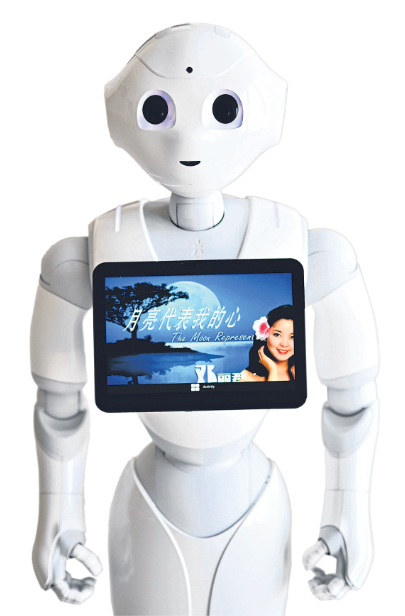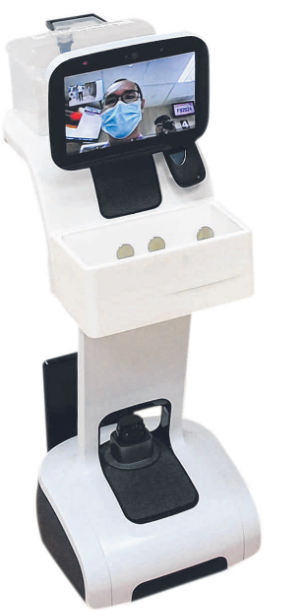 Madam Mariamah Ismail and Madam Lee Lim Song having a session with Pepper the robot, which can demonstrate simple movements for exercise, at Changi General Hospital. ST PHOTOS: LIM YAOHUI
Madam Mariamah Ismail and Madam Lee Lim Song having a session with Pepper the robot, which can demonstrate simple movements for exercise, at Changi General Hospital. ST PHOTOS: LIM YAOHUI
Life (6 July 2022)
Robots to the Rescue
They are changing the face of healthcare by interacting with patients, delivering medicine, helping with rehabilitation and visiting housebound patients
At a ward in Changi General Hospital (CGH), a 120cm-tall robot calls out to patients: “Hello everyone, I am Pepper. Let’s do an exercise together.”
The embodiment of the smileyface emoji, Pepper can respond to audio cues in English and is programmed to engage when patients are unresponsive too. The robot demonstrates simple movements for exercise and also gets patients to sing or recognise songs.
Robots like Pepper are changing the face of healthcare in Singapore by interacting with patients and complementing the work of nurses. CGH alone deploys about 50 robots, including telepresence robots at the Intensive Care Unit and Covid-19 community treatment facilities. These robots help patients make teleconsultations with doctors and video calls to loved ones.
CGH also has cleaning robots and robots that move medication, medical specimens and patients’ case notes, as well as heavy items such as patients’ meals and beds.
The Pepper robot deployed in the wards is the creation of Soft- Bank Robotics. Pepper robots can be programmed for various functions. They have been deployed at Changi Airport to work in retail and can potentially teach preschoolers.
Pepper was first trialled in CGH in 2019 and has since been used in the wards and the Geriatric Day Hospital at CGH. CGH’s nurses worked with programmers to develop physical activities and cognitive activities suitable for patients.
Patients and staff approve of Pepper, says CGH’s senior nurse clinician Li Fuyin, who is also an advanced practice nurse. Advanced practice nurses are experts who work with doctors and other healthcare professionals to provide complex nursing care to patients.
Pepper conducts group activities for senior patients, including those with functional decline, dementia or delirium. It can engage patients multiple times a day, freeing nurses to spend more time on clinical tasks and interaction with individual patients.
Between three and eight patients get to engage with Pepper in each session. A nurse monitors patients for breathlessness or signs of discomfort or disinterest. In general, patients find Pepper endearing and some families ask where they can buy their own robot companion.
Madam Mariamah Ismail, 86, calls the robot “cantik” (Malay for beautiful) and “cute” after engaging in a session. Another participant, Madam Lee Lim Song, 76, also calls Pepper “cute”.
Senior nurse clinician Li says that more than 200 patients in the ward and outpatient settings have engaged with Pepper and say that sessions are fun and easy to follow. The next stage is to programme Pepper to speak in local dialects.

Other hospitals around Singapore also deploy interactive robots. Alexandra Hospital has used a mobile robot made by multinational robotics company temi to visit housebound patients and provide medication. Tan Tock Seng Hospital (TTSH) deploys a temi robot as a pharmacy assistant (see related story on C2).
Other applications of robotic systems in healthcare here include automation systems in pharmacies, as used in CGH and TTSH. TTSH and the National University Health System (NUHS) also deploy robot exoskeletons for rehabilitation.
EMPOWERING HUMANS
Robots offer hope to patients who find their mobility or other daily functions reduced after illness. In 2019, NUHS launched the largest clinical study in Asia to examine how effective bionic exoskeletons are in patient rehabilitation. Pepper can also get patients to recognise songs, such as The Moon Represents My Heart (below) by the late Taiwanese singer Teresa Teng.
 Mr Fabian Yeo suffered three strokes last year. As part of his rehabilitation therapy, he uses the robot H-Man, which exercises his arm and hand through gameplay. ST PHOTO: NG SOR LUAN
Mr Fabian Yeo suffered three strokes last year. As part of his rehabilitation therapy, he uses the robot H-Man, which exercises his arm and hand through gameplay. ST PHOTO: NG SOR LUAN
Robots delivering medicine and making therapy fun

At Tan Tock Seng Hospital’s (TTSH) Emergency Department Pharmacy, a robot helper dispenses medicine to patients without direct contact. Over at the hospital’s Clinic for Advanced Rehabilitation Therapeutics (Cart), robots make therapy less boring for patients recovering from strokes.
Patients and hospital staff tend to find robot helpers endearing. Senior pharmacist Freddy Tang says that when patients see the robot coming with their medicine, they are surprised at first, but “take to it very well”.
“Even the elderly are pleased with it,” he adds.
His department nicknamed their robot assistant Pillbot.
“We call it our little helper,” he says. “It’s part of the family.” Pillbot moves between preprogrammed stations around the hospital. It has a monitor that allows a pharmacist to perform teleconsultations or ask a nurse to find a patient.
Mr Tang says Pillbot has been in use almost daily since October last year. The robot helped dispense medicine to patients in high-risk wards, including those suffering from Covid-19.
Previously, pharmacists might have to change in and out of personal protective equipment (PPE) 10 times a day while visiting such wards. Using Pillbot saves time and reduces the use of PPE.
Pillbot is a robot designed by multinational firm temi, which also has a Singapore distributor. Robots by temi have been used by Alexandra Hospital to visit housebound patients and provide teleconsultations. Another temi robot plays tour guide at the National Gallery Singapore.
Pillbot is programmed via a cellphone app. “It’s very userfriendly,” says Mr Tang.
Another user-friendly robot is making therapy less boring for patients at TTSH.
H-Man is manufactured by Articares following a collaborative research project between Nanyang Technological University and TTSH’s Cart.
The robot has a computer screen, joysticks of various shapes and a resting pad. The joystick and resting pad are shaped like the letter H, hence the robot’s name.
The user manipulates the joystick
to play games like shooting
down a drone or netting fish. All
are actions that exercise the muscles
of the arm and hand.
Ms Tegan Plunkett, principal
occupational therapist at TTSH,
says H-Man is versatile and can
provide guiding force or resistance
as needed, depending on
the user’s ability and therapy
goals.
It also allows users to complete
rehabilitation sessions in their
own time, without needing to
travel to the centre.
Mr Fabian Yeo, 55, who works
in the legal department of an
accounting firm, had three
strokes last year which affected
his right side. Once he returned
to work, he found it difficult to
visit the clinic regularly for rehabilitation
sessions because of his
schedule.
He was loaned an H-Man robot
to take home. This allowed him to
complete several hundred movements
on the robot daily, says Ms
Plunkett.
Mr Yeo says the gameplay is a
more interesting way of performing
repetitive movements such as
extension and stretching.
His son, 21, and daughter, 19,
were interested in H-Man as a
game console.
“They would say they wanted
to play with it and I would say:
‘No, it’s daddy’s, go back to your
Xbox,’” says Mr Yeo with a laugh.